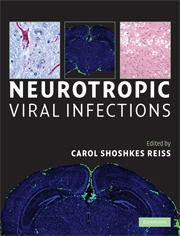Book contents
- Frontmatter
- Contents
- List of contributors
- Foreword
- Preface and acknowledgments
- Section I Introduction: RNA viruses
- Section II Introduction: retroviruses, DNA viruses, and prions
- Section III Introduction: immunity, diagnosis, vector, and beneficial uses of neurotropic viruses
- 14 Innate immunity in viral encephalitis
- 15 Role of Toll-like receptors in neurotropic viral infections
- 16 Neuroendocrine-immune interactions in neurotropic viral infections
- 17 Epidemiology of viral encephalitis
- 18 Pathogen surveillance and discovery
- 19 Clinical management of viral encephalitis
- 20 Influences of arthropod vectors on encephalitic arboviruses
- 21 The role of bats as reservoir hosts of emerging neurological viruses
- 22 Viral oncolysis of glioblastoma
- 23 Viral gene therapy for central nervous system diseases
- Index
- Plate section
- References
15 - Role of Toll-like receptors in neurotropic viral infections
from Section III - Introduction: immunity, diagnosis, vector, and beneficial uses of neurotropic viruses
Published online by Cambridge University Press: 22 August 2009
- Frontmatter
- Contents
- List of contributors
- Foreword
- Preface and acknowledgments
- Section I Introduction: RNA viruses
- Section II Introduction: retroviruses, DNA viruses, and prions
- Section III Introduction: immunity, diagnosis, vector, and beneficial uses of neurotropic viruses
- 14 Innate immunity in viral encephalitis
- 15 Role of Toll-like receptors in neurotropic viral infections
- 16 Neuroendocrine-immune interactions in neurotropic viral infections
- 17 Epidemiology of viral encephalitis
- 18 Pathogen surveillance and discovery
- 19 Clinical management of viral encephalitis
- 20 Influences of arthropod vectors on encephalitic arboviruses
- 21 The role of bats as reservoir hosts of emerging neurological viruses
- 22 Viral oncolysis of glioblastoma
- 23 Viral gene therapy for central nervous system diseases
- Index
- Plate section
- References
Summary
Introduction: TLRs and viruses
Toll-like receptors and their specificity
Toll-like receptors (TLRs) are pattern recognition proteins found both on cell surfaces as well as within intracellular compartments. Originally defined on the basis of their homology to the Drosophila protein Toll, which is important in the fruit fly defense against fungal infections [1], mammalian TLRs were first demonstrated to be critical in determining whether animals develop shock after challenge with bacterial lipopolysaccharide (LPS). The interaction between E.coli LPS and TLR4 leads to a series of events resulting in the production of cytokines and inflammatory mediators that affect vascular permeability and that ultimately cause a decrease in blood pressure and death of the animal. Subsequent studies have revealed a role for TLRs in the immune responses not only to bacteria but also to fungi, parasites, and viruses.
TLRs are a family of proteins with a structure including an N-terminal pattern recognition domain composed of leucine-rich repeats which form a molecular scaffold and a cytosolic C-terminal Toll-interleukin-1 receptor (TIR) domain that interacts with a series of adapter proteins. Engagement of TLR adapters ultimately leads to intracellular signaling events that induce the production of chemokines and cytokines (Figure 15.1). The human genome encodes 10 different TLR proteins, all of which are homologous to the interleukin-1 receptor (IL-1R) protein in their TIR domain. While TLRs are pattern recognition proteins (recognizing viruses and bacteria predominantly through their leucine-rich repeat regions), they initiate the production of cytokines and chemokines that directly (through activation of other cells) or indirectly (through stimulating migration of immune cells) result in the initial host response to infection.
- Type
- Chapter
- Information
- Neurotropic Viral Infections , pp. 292 - 299Publisher: Cambridge University PressPrint publication year: 2008



